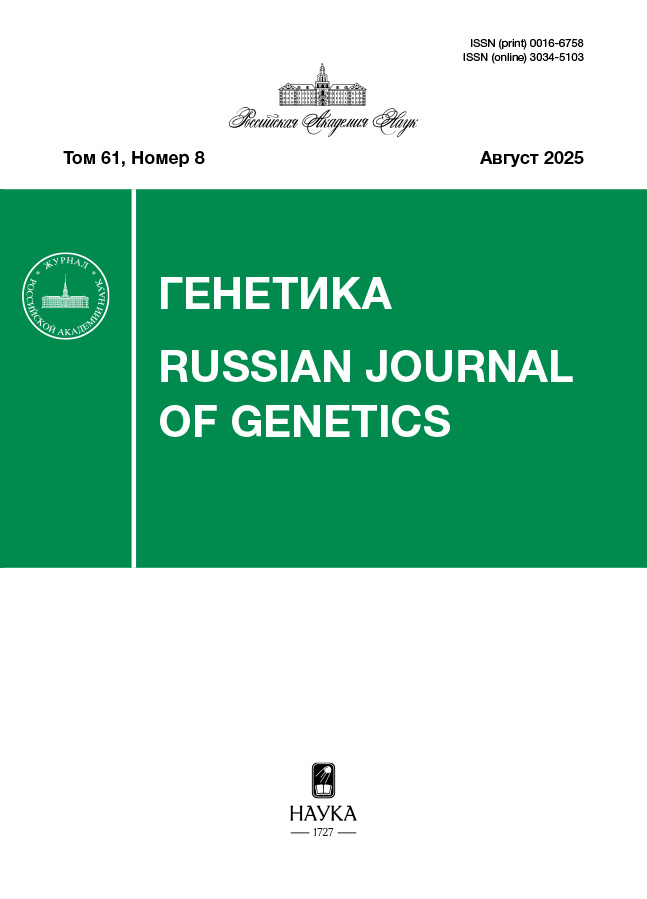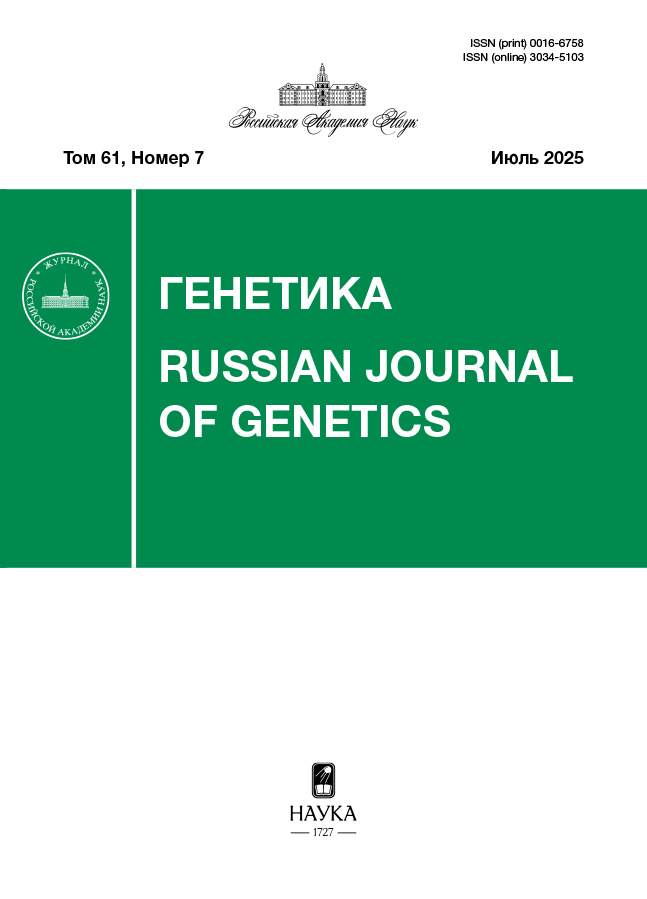Влияние холодового стресса на содержание антоцианов и экспрессию генов пути биосинтеза антоцианов в листьях картофеля Solanum tuberosum L.
- Авторы: Быкова А.В.1, Мелешин А.А.1, Щенникова А.В.1, Кочиева Е.З.1,2
-
Учреждения:
- Институт биоинженерии им. К.Г. Скрябина, Федеральный исследовательский центр «Фундаментальные основы биотехнологии» Российской академии наук
- Московский государственный университет им. М.В. Ломоносова, Биологический факультет
- Выпуск: Том 61, № 7 (2025)
- Страницы: 71-82
- Раздел: ГЕНЕТИКА РАСТЕНИЙ
- URL: https://cardiosomatics.ru/0016-6758/article/view/693616
- DOI: https://doi.org/10.31857/S0016675825070058
- ID: 693616
Цитировать
Полный текст
Аннотация
Холодовой стресс негативно влияет на онтогенез растений, степень холодостойкости которых связана в числе прочего с накоплением антоцианов, обладающих антиоксидантной активностью. Цель данной работы – анализ эффекта холодового стресса на содержание антоцианов и регуляцию их биосинтеза у картофеля (Solanum tuberosum L.). В листьях растений сорта Леди Клэр, подвергнутых двухдневному низкотемпературному воздействию с последующим восстановительным периодом, в динамике эксперимента была определена экспрессия генов биосинтеза антоцианов. Выявлена значительная активация регуляторных (StHY5, StJAF13) и структурных (StCHS2, StCHI, StF3H, StDFR) генов пути в начале стресса и к концу фазы восстановления. Экспрессия структурного гена StANS не менялась. В тех же листьях было определено содержание антоцианов и показано его увеличение в начале и в конце холодового стресса. Обнаружено, что сходная динамика экспрессии генов (кроме StANS) согласуется с колебаниями количества антоцианов. В целом продемонстрировано, что пониженные температуры стимулируют экспрессию генов биосинтеза антоцианов и накопление антоцианов в листьях растений картофеля. Полученные данные могут способствовать пониманию молекулярного механизма регуляции биосинтеза антоцианов в ответ на абиотические стрессы.
Ключевые слова
Об авторах
А. В. Быкова
Институт биоинженерии им. К.Г. Скрябина, Федеральный исследовательский центр «Фундаментальные основы биотехнологии» Российской академии наук
Email: kulakova_97@mail.ru
Москва, 119071 Россия
А. А. Мелешин
Институт биоинженерии им. К.Г. Скрябина, Федеральный исследовательский центр «Фундаментальные основы биотехнологии» Российской академии наук
Email: kulakova_97@mail.ru
Москва, 119071 Россия
А. В. Щенникова
Институт биоинженерии им. К.Г. Скрябина, Федеральный исследовательский центр «Фундаментальные основы биотехнологии» Российской академии наук
Email: kulakova_97@mail.ru
Москва, 119071 Россия
Е. З. Кочиева
Институт биоинженерии им. К.Г. Скрябина, Федеральный исследовательский центр «Фундаментальные основы биотехнологии» Российской академии наук; Московский государственный университет им. М.В. Ломоносова, Биологический факультет
Автор, ответственный за переписку.
Email: kulakova_97@mail.ru
Москва, 119071 Россия; Москва, 119991 Россия
Список литературы
- Kidokoro S., Shinozaki K., Yamaguchi-Shinozaki K. Transcriptional regulatory network of plant cold-stress responses // Trends Plant Sci. 2022. V. 27(9). P. 922–935. https://doi.org/10.1016/j.tplants.2022.01.008
- Apel K., Hirt H. Reactive oxygen species: Metabolism, oxidative stress, and signal transduction // Annu. Rev. Plant Biol. 2004. V. 55. P. 373–399. https://doi.org/10.1146/annurev.arplant.55.031903.141701
- Bulgakov V.P., Fialko A.V., Yugay Y.A. Involvement of epigenetic factors in flavonoid accumulation during plant cold adaptation // Plant Physiol. Biochem. 2024. V. 216. https://doi.org/10.1016/j.plaphy.2024.109096
- Fukumoto L.R., Mazza G. Assessing antioxidant and prooxidant activities of phenolic compounds // J. Agric. Food Chem. 2000. V. 48(8). P. 3597–3604. https://doi.org/10.1021/jf000220w
- Neill S.O., Gould K.S. Anthocyanins in leaves: Light attenuators or antioxidants? // Funct. Plant Biol. 2003. V. 30. P. 865–873. https://doi.org/10.1071/FP03118
- Ahmed N.U., Park J.-I., Jung H.-J. et al. Characterization of dihydroflavonol 4-reductase (DFR) genes and their association with cold and freezing stress in Brassica rapa // Gene. 2014. V. 550. P. 46–55. https://doi.org/10.1016/j.gene.2014.08.013
- Naing A.H., Kim C.K. Abiotic stress-induced anthocyanins in plants: Their role in tolerance to abiotic stres-ses // Physiol. Plant. 2021. V. 172(3). P. 1711–1723. https://doi.org/10.1111/ppl.13373
- Xu Z., Mahmood K., Rothstein S.J. ROS induces anthocyanin production via late biosynthetic genes and anthocyanin deficiency confers the hypersensitivity to ros-generating stresses in Arabidopsis // Plant Cell Physiol. 2017. V. 58(8). P. 1364–1377. https://doi.org/10.1093/pcp/pcx073
- Dar N.A., Mir M.A., Mir J.I. et al. MYB-6 and LDOX-1 regulated accretion of anthocyanin response to cold stress in purple black carrot (Daucus carota L.) // Mol. Biol. Rep. 2022. V. 49(6). P. 5353–5364. https://doi.org/10.1007/s11033-021-07077-3
- Pietrini F., Iannelli M.A., Massacci A. Anthocyanin accumulation in the illuminated surface of maize leaves enhances protection from photo-inhibitory risks at low temperature, without further limitation to photosynthesis // Plant Cell Environ. 2002. V. 25. P. 1251–1259. https://doi.org/10.1046/j.1365-3040.2002.00917.x
- Li Z., Vickrey T.L., McNally M.G. et al. Assessing anthocyanin biosynthesis in Solanaceae as a model pathway for secondary metabolism // Genes (Basel). 2019. V. 10(8). https://doi.org/10.3390/genes10080559
- Xu W., Dubos C., Lepiniec L. Transcriptional control of flavonoid biosynthesis by MYB-bHLH-WDR complexes // Trends Plant Sci. 2015. V. 20(3). P. 176–185. https://doi.org/10.1016/j.tplants.2014.12.001
- Lloyd A., Brockman A., Aguirre L. et al. Advances in the MYB-bHLH-WD repeat (MBW) pigment regulatory model: Addition of a WRKY factor and co- option of an anthocyanin MYB for betalain regulation // Plant Cell Physiol. 2017. V. 58. P. 1431–1441. https://doi.org/10.1093/pcp/pcx075
- Gonzalez A., Zhao M., Leavitt J.M., Lloyd A.M. Regulation of the anthocyanin biosynthetic pathway by the TTG1/bHLH/Myb transcriptional complex in Arabidopsis seedlings // Plant J. 2008. V. 53. P. 814–827. https://doi.org/10.1111/j.1365-313X.2007.03373.x
- Hichri I., Barrieu F., Bogs J. et al. Recent advances in the transcriptional regulation of the flavonoid biosynthetic pathway // J. Exp. Bot. 2011. V. 62. P. 2465–2483. https://doi.org/10.1093/jxb/erq442
- Maier A., Schrader A., Kokkelink L. et al. Light and the E3 ubiquitin ligase COP1/SPA control the protein stability of the MYB transcription factors PAP1 and PAP2 involved in anthocyanin accumulation in Arabidopsis // Plant J. 2013. V. 74. P. 638–651. https://doi.org/10.1111/tpj.12153
- An J.P., Qu F.J., Yao J.F. et al. The bZIP transcription factor MdHY5 regulates anthocyanin accumulation and nitrate assimilation in apple // Hortic. Res. 2017. V. 4. 17056. https://doi.org/10.1038/hortres.2017.23
- Kim S., Hwang G., Lee S. et al. High ambient temperature represses anthocyanin biosynthesis through degradation of HY5 // Front. Plant Sci. 2017. V. 8. https://doi.org/10.3389/fpls.2017.01787
- Liu B., Wang X.Y., Cao Y. et al. Factors affecting freezing tolerance: A comparative transcriptomics study between field and artificial cold acclimations in overwintering evergreens // Plant J. 2020. V. 103(6). P. 2279–2300. https://doi.org/10.1111/tpj.14899
- Li L., Ban Z.-J., Li X.-H. et al. Differential expression of anthocyanin biosynthetic genes and transcription factor PcMYB10 in pears (Pyrus communis L.) // PLoS One. 2012. V. 7. https://doi.org/10.1371/journal.pone.0046070
- Gaiotti F., Pastore C., Filippetti I. et al. Low night temperature at veraison enhances the accumulation of anthocyanins in Corvina grapes (Vitis Vinifera L.) // Sci. Rep. 2018. V. 8(1). P. 8719. https://doi.org/10.1038/s41598-018-26921-4
- He Q., Ren Y., Zhao W. et al. Low temperature promotes anthocyanin biosynthesis and related gene expression in the seedlings of purple head chinese cabbage (Brassica rapa L.) // Genes (Basel). 2020. V. 11(1). https://doi.org/10.3390/genes11010081
- Zhang Q., Zhai J., Shao L. et al. Accumulation of anthocyanins: an adaptation strategy of Mikania micrantha to low temperature in winter // Front. Plant Sci. 2019. V. 10. https://doi.org/10.3389/fpls.2019.01049
- Li P., Li Y.J., Zhang F.J. et al. The Arabidopsis UDP-glycosyltransferases UGT79B2 and UGT79B3, contribute to cold, salt and drought stress tolerance via modulating anthocyanin accumulation // Plant J. 2017. V. 89(1). P. 85–103. https://doi.org/10.1111/tpj.13324
- Meng X., Yin B., Feng H.L. et al. Overexpression of R2R3-MYB gene leads to accumulation of anthocyanin and enhanced resistance to chilling and oxidative stress // Biologia Plantarum. 2014. V. 58. P. 121–130. https://doi.org/10.1007/s10535-013-0376-3
- Liu H., Able A.J., Able J.A. Priming crops for the future: Rewiring stress memory // Trends Plant Sci. 2022. V. 27(7). P. 699–716. https://doi.org/10.1016/j.tplants.2021.11.015
- Tengkun N., Dongdong W., Xiaohui M. et al. Analysis of key genes involved in potato anthocyanin biosynthesis based on genomics and transcriptomics data // Front. Plant Sci. 2019. V. 10. https://doi.org/10.3389/fpls.2019.00603
- Liu Y., Tikunov Y., Schouten R.E. et al. Anthocyanin biosynthesis and degradation mechanisms in Solanaceous vegetables: A review // Front. Chem. 2018. V. 6. P. 1–17. https://doi.org/10.3389/fchem.2018.00052
- D'Amelia V., Villano C., Batelli G. et al. Genetic and epigenetic dynamics affecting anthocyanin biosynthesis in potato cell culture // Plant Sci. 2020. V. 298. https://doi.org/10.1016/j.plantsci.2020.110597
- Strygina K.V., Kochetov A.V., Khlestkina E.K. Genetic control of anthocyanin pigmentation of potato tissues // BMC Genet. 2019. V. 20. Suppl. 1. 27. https://doi.org/10.1186/s12863-019-0728-x
- D'Amelia V., Aversano R., Ruggiero A. et al. Subfunctionalization of duplicate MYB genes in Solanum commersonii generated the cold-induced ScAN2 and the anthocyanin regulator ScAN1 // Plant Cell Environ. 2018. V. 41(5). P. 1038–1051. https://doi.org/10.1111/pce.12966
- Yan C., Zhang N., Wang Q. et al. The effect of low temperature stress on the leaves and MicroRNA expression of potato seedlings // Front. Ecol. Evol. 2021. V. 9. https://doi.org/10.3389/fevo.2021.727081
- Bao Y., Nie T., Wang D., Chen Q. Anthocyanin regulatory networks in Solanum tuberosum L. leaves elucidated via integrated metabolomics, transcriptomics, and StAN1 overexpression // BMC Plant Biol. 2022. V. 22(1). P. 228. https://doi.org/10.1186/s12870-022-03557-1
- Folch J., Lees M., Sloane Stanley G.H. A simple method for the isolation and purification of total lipids from animal tissues // J. Biol. Chem. 1957. V. 226(1). P. 497–509.
- Lee J., Durst R.W., Wrolstad R.E. Determination of total monomeric anthocyanin pigment content of fruit juices, beverages, natural colorants, and wines by the pH differential method: collaborative study // J. AOAC Int. 2005. V. 88(5). P. 1269–1278.
- Lopez-Pardo R., Ruiz de Galarreta J.I., Ritter E. Selection of housekeeping genes for qRT-PCR analysis in potato tubers under cold stress // Mol. Breeding. 2013. V. 31. P. 39–45. https://doi.org/10.1007/s11032-012-9766-z
- Tang X., Zhang N., Si H., Calderón-Urrea A. Selection and validation of reference genes for RT-qPCR ana- lysis in potato under abiotic stress // Plant Methods. 2017. V. 13. P. 85. https://doi.org/10.1186/s13007-017-0238-7
- Heijde M., Binkert M., Yin R. et al. Constitutively active UVR8 photoreceptor variant in Arabidopsis // Proc. Natl Acad. Sci. USA. 2013. V. 110. P. 20326–20331. https://doi.org/10.1073/pnas.1314336110
- Nascimento L.B.D.S., Tattini M. Beyond photoprotection: The multifarious roles of flavonoids in plant terrestrialization // Int. J. Mol. Sci. 2022. V. 23(9). https://doi.org/10.3390/ijms23095284
- Jezek M., Allan A.C., Jones J.J., Geilfus C.M. Why do plants blush when they are hungry? // New Phytol. 2023. V. 239(2). P. 494–505. https://doi.org/10.1111/nph.18833
- Shi L., Li X., Fu Y., Li C. Environmental stimuli and phytohormones in anthocyanin biosynthesis: A comprehensive review // Int. J. Mol. Sci. 2023. V. 24(22). https://doi.org/10.3390/ijms242216415
- Wingler A., Tijero V., Müller M. et al. Interactions between sucrose and jasmonate signalling in the response to cold stress // BMC Plant Biol. 2020. V. 20(1). P. 176. https://doi.org/10.1186/s12870-020-02376-6
- Tena N., Martín J., Asuero A.G. State of the art of anthocyanins: antioxidant activity, sources, bioavailability, and therapeutic effect in human health // Anti- oxidants (Basel). 2020. V. 9(5). https://doi.org/10.3390/antiox9050451
- D'Amelia V., Aversano R., Batelli G. et al. High AN1 variability and interaction with basic helix-loop-helix co-factors related to anthocyanin biosynthesis in potato leaves // Plant J. 2014. V. 80(3). P. 527–540. https://doi.org/10.1111/tpj.12653
- Ahmed N.U., Park J.I., Jung H.J. et al. Anthocyanin biosynthesis for cold and freezing stress tolerance and desirable color in Brassica rapa // Funct. Integr. Genomics. 2015. V. 15(4). P. 383–394. https://doi.org/10.1007/s10142-014-0427-7
- Zhang B., Hu Z., Zhang Y. et al. A putative functional MYB transcription factor induced by low temperature regulates anthocyanin biosynthesis in purple kale (Brassica oleracea var. acephala f. tricolor) // Plant Cell Rep. 2012. V. 31. P. 281–289. https://doi.org/ 10.1007/s00299-011-1162-3
- Gangappa S.N., Botto J.F. The multifaceted roles of HY5 in plant growth and development // Mol. Plant. 2016. V. 9(10). P. 1353–1365. https://doi.org/10.1016/j.molp.2016.07.002
- Gouot J.C., Smith J.P., Holzapfel B.P. et al. Grape berry flavonoids: A review of their biochemical responses to high and extreme high temperatures // J. Exp. Bot. 2019. V. 70(2). P. 397–423. https://doi.org/10.1093/jxb/ery392
- Tan Y., Wen B., Xu L. et al. High temperature inhi- bited the accumulation of anthocyanin by promoting ABA catabolism in sweet cherry fruits // Front. Plant Sci. 2023. V. 14. 1079292. https://doi.org/10.3389/fpls.2023.1079292
Дополнительные файлы











